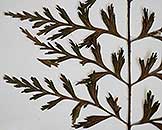Asplenium lividum Mett. ex Kuhn
Synonyms |
Asplenium bernieri Cordem |
|---|---|
Common name |
|
Description |
Rhizome suberect, up to 7 mm diameter; rhizome scales 1-3 x 0.2 mm, brown, lanceolate in outline, entire, pointed. Fronds not proliferous, tufted or slightly spaced, arching or hanging, firmly herbaceous. Stipe up to 20 cm, matt brown or green above and black beneath, often darker towards the base, set with scales similar to the rhizome, otherwise glabrous at maturity. Lamina 13-48 cm × 6-9 cm, 2-pinnate to weakly 3-pinnatifid, narrowly oblong-lanceolate in outline, lowest pinnae not reduced, apical pinnae decrescent, linear and much-lobed. Pinnae 15-21 pairs, subopposite to alternate, hairless, pinnatifid, incised more than 1/2 way to the costa in oblanceolate to linear lobes, the lobes of the pinnae more or less equal except for the basal acroscopic lobe that is larger than the rest; vennation pinnate, margins toothed. Sori 1-6 per lobe, situated alongside the costa between pinna lobes, linear, present on each lobe, linear, 1-7 mm long; indusium entire, linear, membranous, 0.3-0.5 mm wide. |
Notes | Differs from A. aethiopicum by having narrow fronds, small rhizome scales, long sori clustered along the costa. |
Derivation | lividus: a bluish-leaden colour, reference unclear. |
Habitat | On moss covered boulders in deep shade along streams in evergreen forest, moist forest. |
Distribution worldwide | Africa, tropical America. |
Distribution in Africa |
Angola, Cameroon, Kenya, Malawi, Mozambique, Rwanda, Sierra Leone, South Africa, Tanzania , Uganda, Zambia, Zimbabwe. |
Growth form |
Epiphytic, lithophytic. |
Literature |
|

